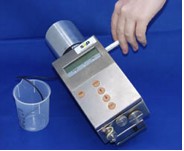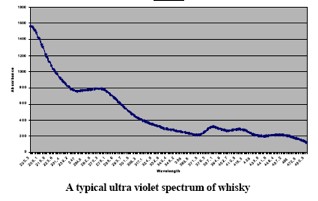

Click here for the PDF version
Foreword:
The aim of this report is to present a scientific article to a wider public. For the full article please refer to the original reference:
MacKenzie, W.M. and R.I. Aylott, Analytical strategies to confirm Scotch whisky authenticity. Part II: Mobile brand authentication. Analyst, 2004. 129(7): p. 607-12.
Brief summary of the article:
Diageo is the world's leading premium drinks business and whisky producer. Whisky is considered as a luxury product, which is prone to counterfeiting and other manipulation. Diageo Brand Technical Centre, Mestrie, UK in collaboration with the company Spectroscopic and Analytical Developments, West Grinstead, UK have developed a portable analytical device to validate the authenticity of genuine whiskies.

SAD Brand Authenticator ©
Introduction:
Diageo is the world's leading premium drinks business and the biggest owner of whisky distilleries in Scotland. Diageo Scotch whisky brands includes Johnnie Walker, J&B and Classic Malts such as Cragganmore, Dalwhinnie, Glenkinchie, Lagavulin, Oban and Talisker.
Proof of authenticity is important for the whisky distillers and dealers and the development of a portable device to able to confirm the authenticity of the product is important, like in South America, but also sometimes in Europe (eg., the Johnnie Walker Black Label story in UK in 2003). Counterfeit whiskies can be diluted, made of another spirit or mixed with toxic compounds, like methanol.
The device:
Dimension
It is a portable device (see picture above) of 1.6 kg of about 18 x 10 x 0.7 cm working on a 9V battery.
How does it work?
This device is a portable UV spectrophotomer. It contains a special lamp (deuterium lamp) that will illuminate the sample and the residual light going through the sample will be read by a detector (diode array). The amount of light absorbed by the sample (absorbance) and its characteristics (the wavelength pattern) captured by the device will provide a fingerprint of the product (see figure below).

As everyone knows, each whisky has its own flavour and taste profile. These differences are due to the chemical molecules present in the whisky and each molecule will react differently with this light. Since each whisky is different, the fingerprint (pattern) of whisky will be different.
One can analyse some known (identified) whisky samples and then store them in the device. Afterwards, if you want to test your whisky in your local bar, take some of your whisky, insert it with a syringe in the device and type the name of your whisky (e.g., Talisker).
The device will then compare the profile of this whisky with the Talisker profile stored in the device and a light will let you if the whisky is a Talisker or not after about 1 minute.
The conclusion of the article:
This methodology will allow the whisky companies to analyse the authenticity of the whisky, without requiring a fully equipped lab and thus can be use to sample quickly suspected drinks on the field.
Personal comment:
One of the important criteria to determine the authenticity of the sample is based on its malt content/profile. By comparing 35 samples with this device and the gold standard verification process (Gas Chromatography), 3 samples (9 %) would have given a different result (Authentic/Counterfeit) and no comparisons between single malts were reported.
This device is the first step towards a portable device to identify counterfeit from genuine whiskies. This should prevent the whisky drinker to drink something else than its wished dram. Since this publication has been released, Diageo has announced the commercialization of this device (end 2005), suggesting they managed to improve the reliability of the device (software).
P.Brossard ©Jan. 2006